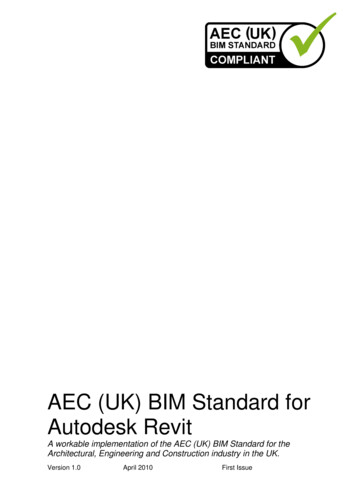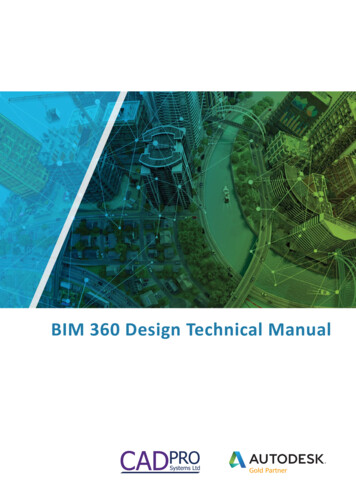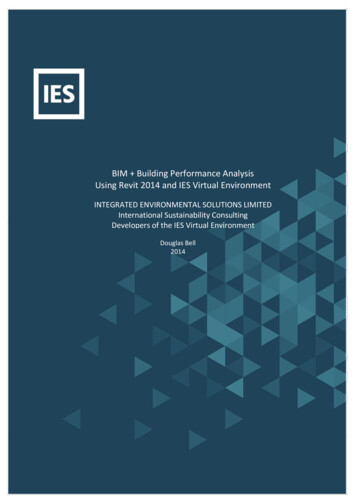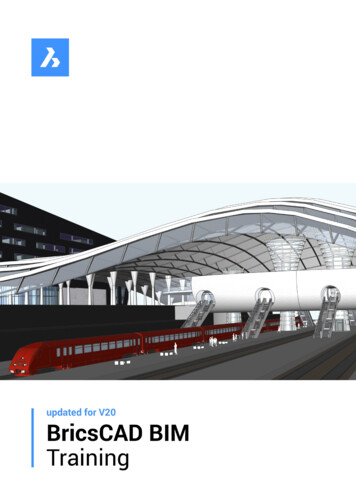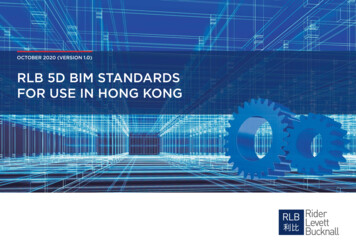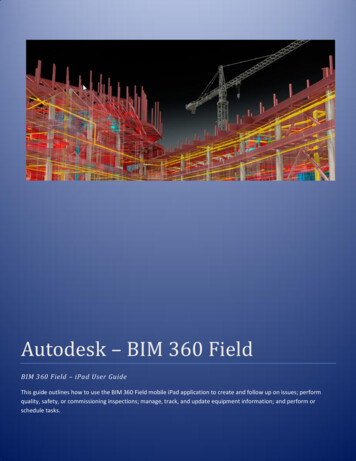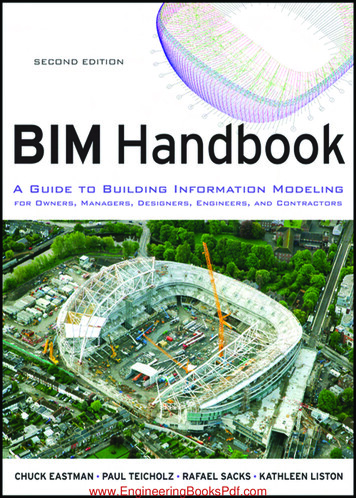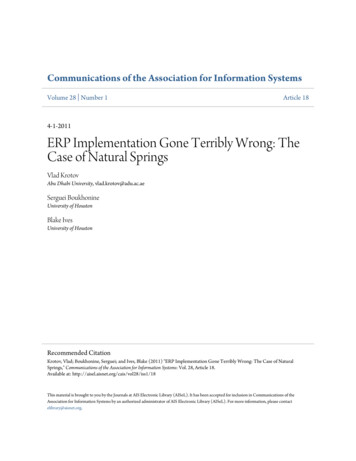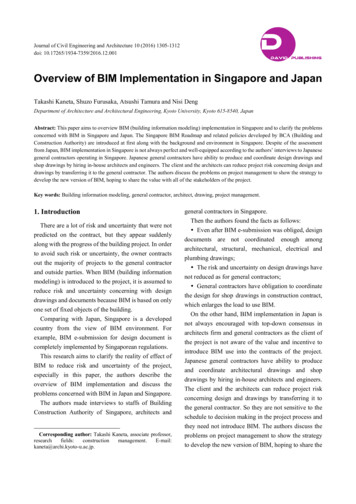
Transcription
DJournal of Civil Engineering and Architecture 10 (2016) 1305-1312doi: iew of BIM Implementation in Singapore and JapanTakashi Kaneta, Shuzo Furusaka, Atsushi Tamura and Nisi DengDepartment of Architecture and Architectural Engineering, Kyoto University, Kyoto 615-8540, JapanAbstract: This paper aims to overview BIM (building information modeling) implementation in Singapore and to clarify the problemsconcerned with BIM in Singapore and Japan. The Singapore BIM Roadmap and related policies developed by BCA (Building andConstruction Authority) are introduced at first along with the background and environment in Singapore. Despite of the assessmentfrom Japan, BIM implementation in Singapore is not always perfect and well-equipped according to the authors’ interviews to Japanesegeneral contractors operating in Singapore. Japanese general contractors have ability to produce and coordinate design drawings andshop drawings by hiring in-house architects and engineers. The client and the architects can reduce project risk concerning design anddrawings by transferring it to the general contractor. The authors discuss the problems on project management to show the strategy todevelop the new version of BIM, hoping to share the value with all of the stakeholders of the project.Key words: Building information modeling, general contractor, architect, drawing, project management.1. IntroductionThere are a lot of risk and uncertainty that were notpredicted on the contract, but they appear suddenlyalong with the progress of the building project. In orderto avoid such risk or uncertainty, the owner contractsout the majority of projects to the general contractorand outside parties. When BIM (building informationmodeling) is introduced to the project, it is assumed toreduce risk and uncertainty concerning with designdrawings and documents because BIM is based on onlyone set of fixed objects of the building.Comparing with Japan, Singapore is a developedcountry from the view of BIM environment. Forexample, BIM e-submission for design document iscompletely implemented by Singaporean regulations.This research aims to clarify the reality of effect ofBIM to reduce risk and uncertainty of the project,especially in this paper, the authors describe theoverview of BIM implementation and discuss theproblems concerned with BIM in Japan and Singapore.The authors made interviews to staffs of BuildingConstruction Authority of Singapore, architects andCorresponding author: Takashi Kaneta, associate mail:kaneta@archi.kyoto-u.ac.jp.general contractors in Singapore.Then the authors found the facts as follows: Even after BIM e-submission was obliged, designdocuments are not coordinated enough amongarchitectural, structural, mechanical, electrical andplumbing drawings; The risk and uncertainty on design drawings havenot reduced as for general contractors; General contractors have obligation to coordinatethe design for shop drawings in construction contract,which enlarges the load to use BIM.On the other hand, BIM implementation in Japan isnot always encouraged with top-down consensus inarchitects firm and general contractors as the client ofthe project is not aware of the value and incentive tointroduce BIM use into the contracts of the project.Japanese general contractors have ability to produceand coordinate architectural drawings and shopdrawings by hiring in-house architects and engineers.The client and the architects can reduce project riskconcerning design and drawings by transferring it tothe general contractor. So they are not sensitive to theschedule to decision making in the project process andthey need not introduce BIM. The authors discuss theproblems on project management to show the strategyto develop the new version of BIM, hoping to share the
Overview of BIM Implementation in Singapore and Japan1306A survey was conducted to grasp the backgroundand facts concerning with implementation of BIM inSingapore as shown in Tables 1-3.construction site. There is no room to improveproductivity in Japanese construction industry, but nowskilled workers are going out of the industry, whichbrings the difficulty to keep the productivity andquality assurance in Japan. This phenomenon may becalled as “2nd Stage to Improve the Productivity”.3. BIM Implementation in Singapore3.2. Singapore BIM Roadmapvalue with all of the stakeholders of the project.2. Methods3.1 BackgroundIn Singapore, the BCA (Building and ConstructionThere are two reasons why BIM should beimplemented in Singapore.One is to reduce the number of foreign workers.About 1/3 of the residents in Singapore are foreigners.Foreign workers have played important roles asblue-collar labors in industries since foundation ofSingapore. They are trained and certified asskilled/multi skilled workers in their home countries,e.g., India, Bangladesh, Myanmar, China, but theirskills do not still meet the requirement of generalcontractors. Singaporean Government has a policy toreduce foreign workers in construction industry byimplementing BIM to design and construction process.Another is to improve the productivity. Productivityin Japanese construction industry was a hot topic in1980s concerning schedule recovery from the delaycaused by troubles with stakeholders surrounding theAuthority) implemented the BIM Roadmap in 2010with the aim that 80% of the construction industry willuse BIM by 2015 [1]. This is part of the government’splan to improve the productivity by up to 25% over thenext decade. To allow the public sector to take the lead,BCAcollaboratedObjectDate3to lead the industry.3.3. Singapore BIM GuideBCA published The Singapore BIM Guide and TheBIM Particular Conditions in 2012 [2]. BIM Guide ispart of the industry’s efforts to demystify BIM and togive clarity on the requirement of BIM usage atdifferent stages of a project. The use of BIM canbe incorporated into the project as part of the scope ofInterviewBCA (Building and Construction Authority)NUS (National University of Singapore)4 general contractors from JapanMarch 8-12, 2016Are there any difficulties or troubles with BIM e-submission?Do you use the same BIM software both in Japan and Singapore?What is the good and bad point with BIM?Is it the same in Japan?Table 3 Topics of interview (BCA and NUS).123(governmenttheir projects from 2012. These are remarkable policyTable 2 Topics of interview (general contractors).12GPEsprocurement entities) to request the use of BIM forTable 1 Outline of survey.MethodwithDoes it meet the requirements as defined in Guideline for Architectural Discipline?If it is successful, why?Are there any opinions against BIM-oriented administration?
Overview of BIM Implementation in Singapore and Japan1307Table 4 BIM e-submission template.Architectural BIM e-submissionStructural BIM e-submissionMEP (mechanical, electrical and plumbing) BIM e-submissionservices under the principal agreement with the help ofBIM particular conditions.BIM Essential Guide For BIM Execution Plan [3]includes a BIM execution plan template which isnecessary for each construction project.It is mandatory for new building projects over5,000 m2 to use BIM e-submission via Corenet on theweb [4]. Templates for BIM e-submission are providedas shown in Table 4 to help the design firms to preparefor the regulatory submission.3.4. Singapore BIM FundSingapore BIM fund, launched in 2012 and updatedin 2013 and 2015, aims to help design firms build upBIM collaboration capability by defraying part of thecost incurred in training, consultancy, software orhardware [5]. General contractors from Japan alsoapplied for this fund, and they are grateful for thisfinancial support by Singaporean Government.4. BIM Adaptation to Projects in Singapore4.1.BIM and StakeholdersSingapore Government has a policy to lead theimplementation of BIM, whereas clients in privatesector are evaluating the value and cost of BIM. It isobliged for architects and consulting engineers to useBIM for design. But the quality and density of thedesign drawings as output of BIM are not alwaysenough, moreover, the drawings are not coordinatedone another in many projects. General contractorsaccept BIM from product manufacturers and giveoutput of BIM to subcontractors.In Singapore, there are typical new professionalscalled as BIM manager and BIM coordinator, who arenot known to Japanese construction industry. They areresponsible for the definition, management andRevitxxxARCHICAD AECOsimxxxxTeklaxcompletion of the BIM execution plan.4.2.BIM e-SubmissionDespite of the assessment from Japan, BIMe-submission in Singapore is not always perfect andwell-equipped according to the authors’ interviews toJapanese general contractors operating in Singapore.Ideally, BIM should be only one model coordinatedby lead architect. After regulatory submission, BIMshould be sent to general contractor for constructionplanning as shown in Fig. 1. This will improveproductivity because they need not input or rewritedesign drawings many times.Even after BIM e-submission was obliged, designdocuments are not coordinated enough amongarchitecture, structure, mechanical, electrical andplumbing engineering as shown in Fig. 2.To avoid this confusion, design drawings should becoordinated by a professional engineer who will beBIM manager as shown in Fig. 3. In Singapore, clientsoften contract consulting engineers as professional ofBIM manager. In this case, BIM manager is the thirdparty to integrate the design information other thanarchitects or general contractors. The role of BIMmanager in project delivery is still case by case basis.5. Barriers of BIM Implementation inSingapore5.1. Difficulties of Projects in SingaporeComparing with Japan, Singapore is a developedcountry from the view of BIM environment. BIMe-submission for design document is completelyimplemented by Singaporean regulations. When BIMis adopted to the building project, it is assumed toreduce risk and uncertainty concerning with designdrawings and documents, because BIM is based on only
1308Overview of BIM Implementation in Singapore and JapanFig. 1 BIM e-submission in ideal model.Fig. 2 BIM e-submission in “as-is” model.Fig. 3 BIM e-Submission in “to-be” model.
Overview of BIM Implementation in Singapore and Japanone set of fixed objects of the building. However,according to the general contractors operating inSingapore, design drawings are not coordinatedenough by design firms whether BIM is adopted or not.General contractors have obligation to coordinate thedesign for shop drawings in construction contract,which enlarges the load to use BIM.5.2 BIM Operators in SingaporeBIM operators are coming from foreign countriessuch as the Philippines. They are generally excellentin operating software and information system. But asthe training for spatial perception in their homecountries may not be enough, some of the operatorsoften misunderstand the solid or structure of thebuilding.To prevent the misunderstanding, some of generalcontractors from Japan assign BIM coordinator toencourage the modeling and to cover the designdrawings and shop drawings in Singapore.5.3 Rely on 2D DrawingsEven after BIM is adopted to the constructionproject, general contractors from Japan uses a lot of2D drawings for decision making by site managers.Meetings with subcontractors are based on 3D BIM,however, the workers use 2D drawings printed onpaper. The style and format of shop drawings do notsometimes fit to the output from BIM. In such cases,general contractors should replace BIM from the oneaccepted from the architects and consultant engineers.6. Differences between Japan and Singapore6.1 Barriers of BIM Implementation in JapanBIM implementation in Japan is developing but notstrategically uniformed, though MLIT (Ministry ofLand, Infrastructure, Transport and Tourism)published BIM Guideline in 2014 after MLIT selectedthree pilot projects from public sector in 2010.As shown in Fig. 4, BIM adopted in Japanese1309construction industry are not compatible one anotherthrough supply chain, because construction market inJapan is so huge. The top 5 super general contractors inJapan have about JPY1.4-1.8 trillion annual grossrevenue, which declines the incentive for contractors todevelop BIM compatible to other contractor’s supplychain.Generally speaking, Japanese firms are not eager toimplement BIM as corporate level, because clients inJapan do not recognize the value created by BIM.There are no articles that encourage BIMimplementation in construction contracts unlessspecially defined. So nobody covers the cost to set upBIM along with the contingency of the project isshrinking. BIM is still on the way to help stakeholdersto reduce risk and uncertainty.6.2 BIM in Construction Industry of Japan andSingaporeIn Singapore, there are only a few kinds of BIMsoftware that are certified for BIM e-submissiontemplate. They are de facto standard of BIM and theyare compatible through supply chain consisted ofproduct manufacturers, architects, consulting engineers,general contractors and subcontractors.The construction market in Singapore is aboutJPY2.2 trillion in 2015 [6], which is small comparingwith Japanese market [7]. It is reasonable to generalizeBIM in Singapore above whole country.6.3 Design Works by Japanese General ContractorsIt is special culture uncommon to other countries thatJapanese general contractors have ability to produceand coordinate design drawings and shop drawings byhiring in-house architects and engineers. With suchgeneral contractors, the client and the architects canreduce project risk concerning design and drawings bytransferring the risk to the general contractors. So theclients and the architects in Japan are not sensitive tothe schedule of decision making in the project process.In other words, they need not introduce BIM because
1310Overview of BIM Implementation in Singapore and JapanFig. 4 BIM in construction industry of Japan and Singapore.Fig. 5 Scheme of further analysis.
Overview of BIM Implementation in Singapore and Japanfront loading and integrated project delivery caused byBIM will make their loads larger in former stage of theprojects.6.4. Research and Development of BIM in Japan1311strategy of BIM implementation. Japanese generalcontractors have ability to produce and coordinatedesign drawings and shop drawings with in-housearchitects and engineers. So the client and thearchitects can reduce project risk concerning designand drawings only if they transfer it to the generalcontractor. They are not always responsible for theschedule of decision making in the project process andthey need not introduce BIM.So it can be concluded that BIM is still on the way tohelp stakeholders to reduce risk and uncertainty. Butthe authors prospect that there is also space forThe authors also reviewed past research such asproduct modeling, integrated information system fordesign and construction, and other original systems.The concept applied to BIM was already developed in1990s. At that time, the trial to define common codingfor all the general contractors was promoted byJapanese Government under the policy to enhanceCALS/EC (continuous acquisition and life-cyclesupport/electronic commerce), which ended withoutsuccess because of the competition with the de factostandard software.As for the general contractors, full turn-key contractis attractive and suitable for BIM implementation toreduce the tasks to find and to check the conflicts indesign drawings.The design firms obtain the advantage to analyzebig data and complicated geographical information byadopting BIM as well as an excellent tool for 3Dpresentation in design phase.The major clients in Japan are interested in adoptingBIM in facility management phase, using as-builtBIM for procurement of reformation.innovation by excellent general contractors, and theauthors will propose a strategy for new business tomanage the project utilizing BIM.General contractors from Japan are operating BIM inSingapore compatible with open system of supplychain. This style is different from the one in Japan eventhey belong to the same company as shown in Fig. 5.Next step it should be analyzed in detail.7. ConclusionsReferencesThis paper described BIM implementation andindicated the barriers concerned with BIM in Japan andSingapore. BIM implementation in Singapore is led byBCA and Singaporean Government. It is a kind ofregulation to make stakeholders together with BIM.BIM implementation in Japan is not alwaysencouraged with the board members in architect firmand general contractors as the client of the project is notaware of the value and incentive to express BIM useinto the contracts of the project.The authors discuss the problems on projectmanagement to show the strategy to develop the[1]AcknowledgmentsAll the people and institutions that contributed to thesurvey are gratefully acknowledged. This research issupported by the Japan Society for the Promotion ofScience (JSPS) Grants-in-Aid for Scientific Research,Challenging Exploratory Research 26630271.[2][3][4][5][6]BCA. 2011. Singapore BIM Roadmap. Accessed June 15,2016. https://www.bca.gov.sg/newsroom/others/pr02112011 BIB.pdf.BCA. 2013. Singapore BIM Guide Version2. AccessedJune 15, 2016. BIMGuide V2.pdf.BCA. 2013. BIM Essential GuideFor BIM Execution Plan.Accessed June 15, 2016. Guide-BEP.pdf.Singapore Government. 2016. BIM e-Submission. AccessedJune 15, 2016. https://www.corenet.gov.sg/ ission.aspx.BCA. 2015. Singapore BIM Fund V2. Accessed June 15,2016. https://www.bca.gov.sg/BIM/bimfund.html.BCA. 2016. Media Release. Accessed June 15, 2016.
1312[7]Overview of BIM Implementation in Singapore and Japanhttps://www.bca.gov.sg/Newsroom/others/BCA MediaRelease Prospects 150116.pdf.Ministry of Land, Infrastructure, Transport and Tourism.2015. Construction Investment Forecast 2015. AccessedJune 15, 2016. http://www.mlit.go.jp/report/press/joho04 hh 000561.html
BIM implementation in Japan is developing but not strategically uniformed, though MLIT (Ministry of Land, Infrastructure, Transport and Tourism) published BIM Guideline in 2014 after MLIT selected three pilot projects from public sector in 2010. As shown in Fig. 4, BIM adopted in Japa


